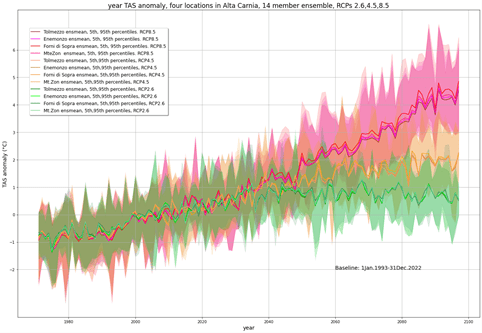(Find the complete article, with figures here)
Climate change is a global phenomenon, whose local scale impacts have specific characteristics that depend on the geographical area taken into account.
Many efforts have been undertaken by the scientific community to transfer, both with regional climate simulations [1] and the so called downscaling techniques [2], future climate information to policymakers, local administrations and citizens, in order to support local adaptation.
The doctoral project named “Development of climate models and scenarios in the Alta Carnia region to support local administrations in designing and monitoring climate adaptation plans and towards a wider scientific culture” started in 2022, from the collaboration between the University of Trieste – Physics Department – and a cluster of municipalities of the “Alta Carnia” region. The project aims at developing bias correction and downscaling techniques over the alpine target area. The complexity of the local orography affects the physical processes that determine the meteorological and climatic conditions and poses a major challenge to the study of future climate scenarios at the very local scales (kilometre or sub-kilometre spatial resolution).
The EURO-CORDEX initiative [3] has conducted many future climate simulations over Europe, according to a rich ensemble of global-regional chain models: the EURO-CORDEX simulation outputs serve as reference for the study of the surface temperature evolution over the Alta Carnia territory, in relation to three different Representative Concentration Pathways – different global pathways of the greenhouse-gases concentrations – RCPs.
By considering the mean behaviour of the simulations outputs, in correspondence of several meteorological stations over the Alta Carnia region, it is possible to notice that the temperature anomaly proceeds almost “regardless” from the particular RCP scenario, almost until the year 2040.
Looking at the surface temperature anomaly by the end of century (2097) for the four different locations, it is possible to notice an average increase of almost +1 °C with respect to the 1993-2015 annual mean temperature for the low-emission scenario (RCP 2.6); this increase is doubled (+2 °C) by the end of the XXI century under the intermediate emission scenario (RCP 4.5) and reaches +4/+5 °C under the business as usual scenario (Figure 1).
The presence of a systematic discrepancy between the temperature outputs from model simulations and the temperature measurements (temperature biases) has been detected: by exploiting some simple yet fundamental principles governing atmospheric thermodynamics, this bias can be decomposed into its main components: one related to the climate models limits in the representation of complex orography, the other related to the particular representation of the climate dynamics implemented by each single climate model.
Then, a second climatic indicator has been considered: the evolution of the “freezing height”, under the RCP 8.5 scenario, in correspondence of the Mt. Zoncolan skying resort. As shown in Figure 2, an increasing temperature trend of +0.4 °C/decade corresponds to an estimate of a vertical shift of the “freezing height” of almost +60 m/decade. With this trend, it is estimated that by 2080 the 0 °C line will be located above the Mt. Zoncolan top, permanently, also during winter.
These are preliminary results, which will be further refined and improved, both from an ensemble statistics point of view and from the bias correction and downscaling technique perspective.
About the author
Francesca Zarabara, from Zuglio (UD), Italy, received her bachelor’s degree in civil engineering from the University of Udine in 2016. In 2018, she obtained her master’s degree in physics from the University of Trieste. She then began working as a mathematics and physics teacher in secondary schools and became interested in climate change, both from a scientific perspective and through her own climate activism. In 2022, she was awarded a “Municipal Doctorate” scholarship, funded by the Agency for Territorial Cohesion and focused on the study of climate change in the Inner Area of the Alta Carnia region. The scholarship is activated in collaboration between the Physics Doctorate Program at the University of Trieste and the Municipality of Paluzza (UD) – Inner Area of the Alta Carnia – for the 37th cycle of doctorates.
Contacts: Francesca Zarabara, francesca.zarabara@phd.units.it
[1] Filippo Giorgi, Thirty years of regional climate modeling: Where are we and where are we going next?, Journal of Geophysical Research: Atmospheres, 2019, 124, 5696–5723, https://doi.org/10.1029/2018JD030094.
[2] Rao Kotamarthi et al., Downscaling techniques for high-resolution climate projections. From global change to local impacts, Cambridge University Press, 2021.
[3] https://cordex.org; https://euro-cordex.net



